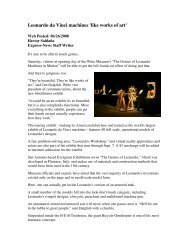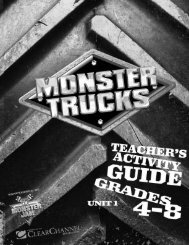Extreme Deep Teacher's Guide.pdf - Evergreen Exhibitions
Extreme Deep Teacher's Guide.pdf - Evergreen Exhibitions
Extreme Deep Teacher's Guide.pdf - Evergreen Exhibitions
Create successful ePaper yourself
Turn your PDF publications into a flip-book with our unique Google optimized e-Paper software.
Procedure<br />
1. Have students pair up.<br />
2. Each team builds a seafloor using clay to form the seafloor features in the bottom of their shoe<br />
box. Make sure they make their seafloors realistic, with a continental shelf and slope, offshore<br />
trenches, mid-ocean ridges, islands and other features in appropriate places.<br />
3. Students mark their boxes so they can identify them later.<br />
4. When the seafloor is completed, have each team tape a sheet of graph paper to the inside of<br />
the box top. Working from the inside of the box top, poke a small hole through the paper and<br />
box top at each intersection on the graph paper.<br />
5. Remove the graph paper. Replace the box top onto the box to represent sea level and tape<br />
shut. Tape the graph paper to the top of your mini-ocean being sure to realign the punched<br />
paper with the holes on the lid.<br />
6. Place in a warm dry place so the clay can harden.<br />
7. Later in the week, have teams swap oceans. Make sure students don’t look into the boxes.<br />
8. Hand out one bamboo skewer to each team. Instruct students to mark the skewer every 1/4<br />
inch with a black fine-tipped marker pen. Every fourth mark (at each inch) should be red.<br />
9. Teams make soundings by gently sliding the bamboo skewer through each hole in the box top,<br />
row by row. For each sounding, have them note the level that the box top reaches on the<br />
skewer, then remove the skewer and record the depth on the graph paper.<br />
10. Students chart their results to identify trenches, sea mounts, ridges, etc.<br />
11. Once their charts are finished, have students open their boxes and compare the box seafloor<br />
with their graph-paper results.<br />
Questions to Close<br />
■ Were you able to locate all the features in your “ocean”?<br />
■ If not, which features didn’t you locate by sounding?<br />
■ What can you conclude about the accuracy of your method?<br />
■ How would you improve upon your method?<br />
■ What would happen if your skewers were marked every 1/8 inch instead of every 1/4 inch?<br />
Adapted from:<br />
FOR SEA-Marine Science Society of the Pacific Northwest. J.A. Kolb, 1993.<br />
Stevens, Betsy, and Amy Pallant. “Build the Ocean Floor” In Dive to the <strong>Deep</strong> Ocean; Voyages of exploration and<br />
discovery; Teacher’s Resource Binder. Austin, TX: Steck-Vaughn Company and Turnstone Publishing Group, Inc., 1999.<br />
Stevens, Betsy, and Amy Pallant. “Map the Ocean Floor” In Dive to the <strong>Deep</strong> Ocean; Voyages of exploration and<br />
discovery; Teacher’s Resource Binder. Austin, TX: Steck-Vaughn Company and Turnstone Publishing Group, Inc., 1999.<br />
Sources<br />
Gross, M. Grant. Oceanography: A view of the Earth. Englewood Cliffs, NJ: Prentice-Hall, Inc., 1972.<br />
Smith, Walter H. OF., David T. Sandwell. 1997. “Global seafloor topography from satellite altimetry and ship depth<br />
soundings.” Science 277: 1956-1962.<br />
23





